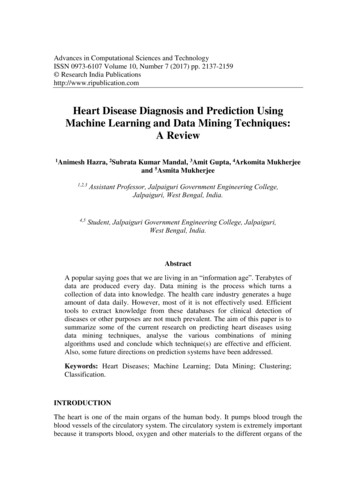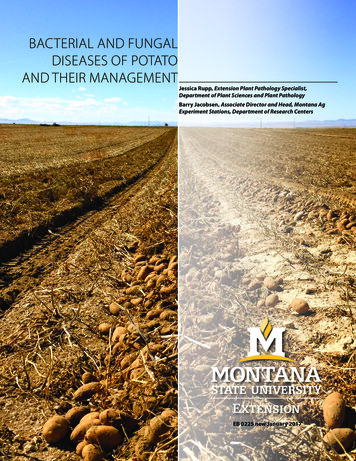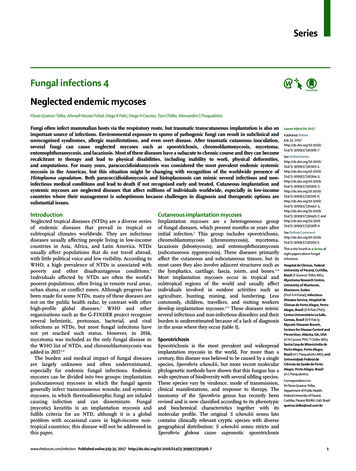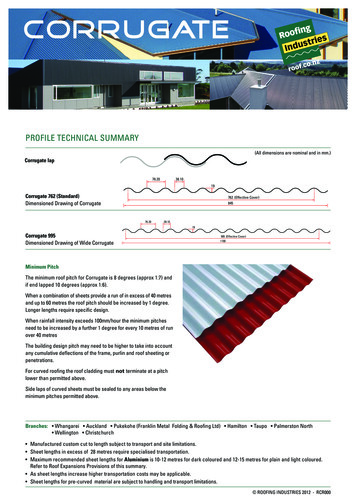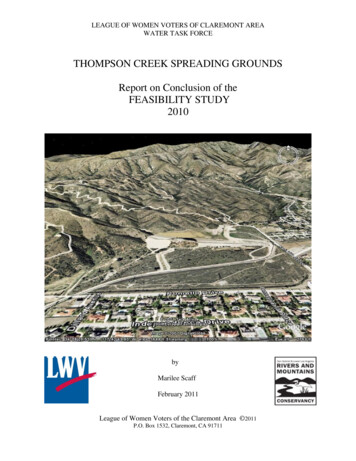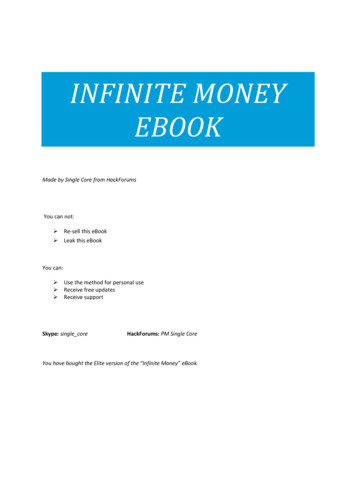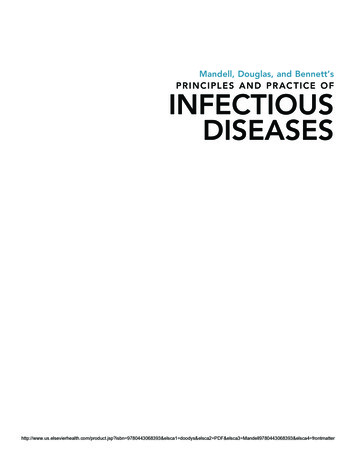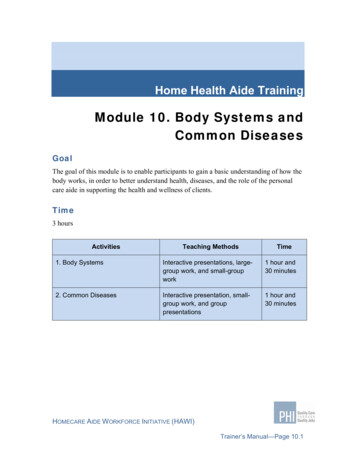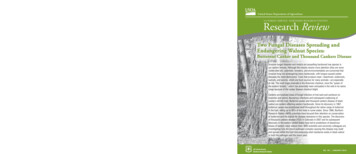
Transcription
United States Department of AgricultureUS FOREST SERVICE NORTHERN RESEARCH STATIONResearch ReviewTwo Fungal Diseases Spreading andEndangering Walnut Species:Butternut Canker and Thousand Cankers DiseaseInvasive fungal diseases and insects are assaulting hardwood tree species inour eastern forests. Although the insects receive more attention (they are morevisible after all), scientists, foresters, and environmentalists are concerned thatinvasive fungi are endangering many hardwoods, with fungus-caused cankerdiseases the most destructive. Trees that produce mast—beechnuts, butternuts,walnuts, and acorns, which are food sources for many animals—are especiallyat risk. The most tragic example is the American chestnut, once the “queen ofthe eastern forests,” which has essentially been extirpated in the wild in its nativerange because of the canker disease chestnut blight.Cankers are localized areas of fungal infection of tree bark and cambium onbranches and stems. Numerous infections and subsequent coalescing ofcankers will kill trees. Butternut canker and thousand cankers disease of blackwalnut are cankers affecting eastern hardwoods. Since its discovery in 1967,butternut canker has established itself throughout the native range of butternutin the East, killing up to 90% of the trees in some states. Since 1990, NorthernResearch Station (NRS) scientists have focused their attention on conservationof butternut and the search for disease resistance in this species. The discoveryof thousand cankers disease (TCD) in Colorado in 2007 and its subsequentdiscovery in the eastern United States have led to predictions of disastrouslosses of eastern black walnut trees. NRS scientists and university colleagues areinvestigating how the insect-pathogen complex causing this disease may buildand spread within the East and assessing what resistance exists in black walnutto both the pathogen and the insect pest.Mature butternut. Photo by T. Davis Sydnor,The Ohio State University, Bugwood.orgUS Forest ServiceNorthern Research StationNO. 28 JANUARY 20161
continued from page oneBUTTERNUT CANKERButternut canker is a disease that threatens the butternut tree (Juglanscinerea), also known as white walnut. It is mostly found in mixed hardwoodforests, sometimes in groups but often as isolated individuals, from NewBrunswick to North Carolina, and westward to Minnesota and Missouri. Thenuts are important as a mast crop and are also used in baking. The woodlooks similar to black walnut but is more easily worked for woodcarving,paneling, and furniture. The first chief of the Forest Service, Gifford Pinchot,paneled his library at Grey Towers with butternut wood. The trees are difficultto propagate and grow in plantations necessary for commercial production.However, butternut is highly valued as a yard tree or in small woodlots.The fungus causing butternut canker (Ophiognomonia clavigignentijuglandacearum, abbreviated as Oc-j ) occurs all over North America andwas first discovered in 1967 in Wisconsin. The canker has spread rapidlythroughout the range of butternut and is extremely virulent. Because of thehost trees’ limited resistance, the fungus is believed to be of nonnative origin.Survival of the butternut species is threatened and the severity of the diseasehas prompted the U.S. Forest Service to consider butternut a “species atrisk.” The fungus attacks other members of the walnut family, but butternut isthe most susceptible native species.Infection by this canker results in sunken, elliptical cankers on branches,stems, and buttress roots and dark brown, elliptical stains beneath the bark;these become large and girdle branches and twigs, then trunk or roots, whichkills the tree.Northern Research Station ScienceInvestigating the biology of the fungus causing butternut canker hasprovided useful insights. The canker predominantly affects butternut, butnaturally produced cankers have been found on other Juglans species,namely black walnut (J. nigra) and Japanese walnut (J. ailantifolia). Artificialinoculations have found that Oc-j can colonize and survive in the woodof several genera, including Carya (hickory), Corylus (hazelnut), Prunus(stone fruits), and Castanea (chestnut). This is evidence that the fungus maybe surviving on other trees in a nonpathogenic state as a reservoir whenbutternuts are not present.Finding insect vectors of butternut canker is another important activityof NRS scientists. Rain splash and wind have been shown to spread Oc-jconidiospores up to about 45 meters. For long-distance transport, the stickyspores can adhere to insects that then carry the spores to isolated butternuttrees. A number of insects have been found capable of disseminating Oc-jconidia, and three beetle species were found able to carry viable conidia forup to 16 days. These potential vectors may explain how apparently isolatedbutternuts become infected, but more studies are needed on conditions andtiming.Butternut canker 17 months after innoculation.Photo by Michael Ostry, U.S. Forest Service.Breeding for resistance to butternut canker is probably the mostimportant aspect of NRS research for fighting butternut canker. Beginning inthe 1990s, healthy butternut trees were being found despite growing in closevicinity to diseased trees. Numerous surveys by forest agencies as well ascontacts from private individuals recorded a number of possibly resistantbutternut trees throughout the range. These trees offer some hope of findingresistance to butternut canker within the natural population. Starting in1990, NRS scientists Mike Ostry and Darroll Skilling of St. Paul, MN (nowboth retired), Melanie Moore of St. Paul, and Paula Pijut, Keith Woeste,and Jim McKenna of the Hardwood Tree Improvement and RegenerationCenter (HTIRC) at Purdue University (West Lafayette, IN) have been deeplyinvolved in research on butternut canker. They have collected twig samplesof possibly resistant butternuts, grafted them onto rootstocks, and plantedthis material in orchards in many different locales and environmentalconditions. These places include an experimental station at Rosemount,MN; the Oconto River Seed Orchard on the Chequamegon-Nicolet NationalForest in Wisconsin; the HTIRC at Purdue University, and several Ministryof Natural Resources locations in Ontario, Canada. Butternut trees at thesesites are used in inoculation studies or allowed to become infected naturally.Survivors can then be used for further breeding. Asian butternuts do showresistance to Oc-j and are being used in hybridization efforts.2
During the search for resistant trees, an unusual appearance was discoveredamong many of the healthier trees. A large proportion of the healthier,possibly resistant, butternuts had distinctive bark that was darker thanthe typical light gray with deeper gray furrows. At first glance, it was easyto mistake these for black walnut trees and there was a correlation foundbetween tree health and bark characteristics. Preliminary molecular studiesof leaf samples of this population are underway to discover if there is anyrelationship between bark type and disease resistance. If this is indeed so,the process of selecting resistant trees will be much more efficient. Otherstudies on bark chemistry have shown a possible correlation between cankerresistance and chemical inhibition of conidial germination, which could bedeveloped as a screening tool for finding resistance.THOUSAND CANKERS DISEASEThousand cankers disease (TCD) is the newest “invasive” insect-diseasecomplex coming to eastern forests. Black walnut is an eastern tree thatproduces wood so highly desirable for furniture and cabinet makingthat it has been planted all over the United States. In the East, the treegrows in forests and in the countryside, often along fence rows; it is alsogrown in plantations as an investment. It is allelopathic, meaning that itproduces phytochemicals that hinder the growth of other plants near itsroots. Unfortunately, in the West, black walnut was planted in the nativerange of Arizona walnut (J. major ) in Arizona, New Mexico, and northernMexico, which allowed it to become infested with the walnut twig beetle(Pityophthorus juglandis ), which has historically fed on Arizona walnutand perhaps on southern California walnut (J. californica). The walnut twigbeetle carries with it the fungus Geosmithia morbida, which causes smallWalnut twig beetle, greatlymagnified; true size is 1.5 to1.9 mm, smaller than half agrain of rice.Photos by Steven Valley, OregonDepartment of Agriculture,Bugwood.org.cankers beneath the bark of the branches and stems of walnut trees. Thesenumerous small cankers, which give the disease its common name, killinfested trees by restricting nutrient flow; a tree typically dies within 3 to4 years of infection. The fungus was described as new to science in 2010.Thus, this new disease complex has expanded its geographic range and wasable to switch to new host species with no co-evolved resistance, acting asa nonnative pest of black walnut in North America and now also in Europe.Since the 1990s, black walnut trees planted in the West have shownwidespread decline. In 2004, extensive mortality in the Front Range ofColorado was linked to the presence of the TCD beetle and fungus complex.The disease is now present in nine western states and continues to spreadinto the native range of black walnut. In 2010, it was found in Tennessee;in 2011, in Virginia and Pennsylvania; and in 2013 in Maryland and Ohio.In late 2013, both the beetle and fungus were found in black walnut treesin northern Italy. In 2014, the fungus was reported on a weevil species thatemerged from stressed black walnut in Indiana, although TCD symptomsand the beetle were not present. The TCD beetle has since been found onlogs at a mill site in Indiana. Long-distance movement of infested logsprobably transported the beetle.Northern Research Station ScienceIn 2012, NRS researcher Robert Venette began work with scientists atthe Pacific Southwest Research Station of the U.S. Forest Service; and atUniversity of Minnesota, University of Missouri, and Purdue University, tobetter understand the threat that walnut twig beetle poses to black walnutand closely related Juglans species. They studied cold tolerance of walnuttwig beetle, the flight capacity of beetles, and the quality of different Juglansspecies for beetle reproduction and found that cold winter temperatures maycause substantial mortality of walnut twig beetle in portions of Minnesota,Wisconsin, South Dakota, and Iowa. In most places where black walnutgrows, though, walnut twig beetle could survive the winter. Walnut twigbeetles do not appear to be strong fliers; most fly less than a quarter milein their lifetime. These results confirm the significant role that movement ofinfested wood products plays in the long distance movement of the insect.Beetle reproduction is affected by different cultivars of black walnut andother Juglans species, offering hope for sources of resistance.In 2016, NRS scientist Jennifer Juzwik will work with the Animal and PlantHealth Inspection Service (USDA APHIS) and Virginia Tech collaboratorsBlack walnut tree showing early symptoms of thousand cankersdisease, in Tennessee. Photo by Jennifer Juzwik, U.S. Forest Service.3
to evaluate the effectiveness of vacuum-steam treatment in eradicatingTCD fungus and walnut twig beetles from veneer logs destined for exportto overseas markets. Current quarantines in numerous countries requiremethyl bromide fumigation of such logs because of TCD presence in theUnited States. She is also collaborating with Purdue and West VirginiaUniversity scientists to study the role of naturally occurring canker diseases,and other insect pests on the development of branch dieback and tree crowndeath in TCD-affected black walnut in Ohio and Tennessee. The ability ofthe fungus causing Fusarium canker and the fungus causing Botryosphaeriabranch dieback are being compared to that of the TCD fungus inexperiments underway in urban parks in Butler County, Ohio, and in aquarantined black walnut plantation in central Indiana. These other fungi hadbeen commonly isolated from cankers on TCD trees in Tennessee and Ohio.In addition, the colonization of TCD-affected trees by invasive ambrosiabeetle species as well as the walnut twig beetle suggests that several insectsmay contribute to the development of TCD. Recently, a weevil species andtwo of the exotic ambrosia beetle species that commonly colonize stressedwalnut, including TCD trees, were found to carry the TCD fungus. The roleof these other insects in spread of the disease is under investigation.Although TCD killed over 60% of black walnuts planted in Boulder, CO,where it was discovered, the disease in the East has not progressed inmany affected trees in Tennessee and Virginia during years of normalprecipitation. Some trees even seem to have “recovered.” Results of studiesto date have led to guarded optimism that TCD will not be another chestnutblight in the eastern United States. It may behave more like oak decline,which requires stress events to predispose black walnut to the complexof insect attack and canker disease development. Disease monitoring andcontinued research will test these hypotheses.Black walnut branch with thousand cankers disease.Photo by Jennifer Juzwik, U.S. Forest Service.23BIOGRAPHIESJennifer Juzwik is a research plantpathologist in the “Restoration andConservation of Rural and UrbanForests” unit in St. Paul, MN. Shereceived her PhD from the Universityof Minnesota, MS from Colorado StateUniversity, and BS from FairmontState College, West Virginia. The etiology, epidemiology, andmanagement of hardwood tree diseases, most recently thousandcankers disease, have dominated her research career.James McKenna is a biologist at the Hardwood TreeImprovement and Regeneration Center (HTIRC) in WestLafayette, IN. He has a BS in plant biology from the University ofCalifornia.Melanie Moore is a biological sciencetechnician at St. Paul, MN, who frequentlypublished with Mike Ostry (retired).She recently received her MS from theUniversity of Minnesota and is workingwith Jennifer Juzwik.Paula M. Pijutis a researchplant physiologist with the HTIRC inWest Lafayette, IN. She received herPhD in horticulture from The OhioState University, a MS in horticulturefrom Murry State University, and a BSin medical technology from MaryvilleCollege of the Sacred Heart. Paula hasworked for the USDA Forest Service since 1989 and joined theHTIRC in 2001. Paula’s research program focuses on forest treebiotechnology and vegetative propagation for tree improvementand conservation.Keith E. Woeste is a research geneticistfor the HTIRC since 1999. His interestsinclude the genetics and breedingof hardwood trees, especially finehardwoods such as walnut, oak, andblack cherry. He earned both MS and PhDdegrees from the University of California,Davis; his BS in botany was from theUniversity of Florida.Robert C. Venette is a research biologist inthe “Restoration and Conservation of Ruraland Urban Forests” unit in St. Paul, MN.He received his PhD from the University ofCalifornia, Davis, and BS from the Universityof Minnesota. He specializes in ecologicalresearch to project the distribution and4impacts of invasive species.
Vegetative propagation (rooted cuttings) and invitro culture (micropropagation) methods areimportant in conserving and producing clonesof possibly resistant butternut or black walnuttrees selected or genetically improved forcanker resistance. Paula Pijut at the HTIRC hasdeveloped methods for vegetative propagationby rooted cuttings by using carefully controlledconditions. Propagation of 5- and 6-year-oldbutternut trees by hardwood and softwoodcuttings has been successful and rooted cuttingsoverwintered in cold-storage had high survivaland good growth when field-planted the followingyear. In vitro micropropagation of black walnutproduces a large volume of genetically identicalmaterial in a relatively short period of time.This material can then be used in research onadventitious root formation in black walnut,which is a limiting factor in clonal walnutpropagation. By using a fog system, black walnutsoftwood cuttings from juvenile seedlings weresuccessfully rooted at rates as high as 71%.These clonal propagation methods developed atHTIRC are a necessary tool for tree breeders andfor conservation efforts, especially because ofbutternut canker and thousand cankers disease.Vegetative propagation of butternut-rooted cuttings.Photo by Paula Pijut, U.S. Forest Service.RESOURCES AND REFERENCESWeb Resources:USDA Forest Service: ogens/USFS S&PF Northeastern Area: www.na.fs.fed.us/spfo/pubs/howtos/ht but/ht but.htmUSFS R&D Northern Research Station: te-info.php?state ColoradoUSFS Southern Research Station:www.srs.fs.usda.gov/pubs/ja/ja schlarbaum002.htmReferences:Ginzel M, Juzwik J. 2014. Geosmithia morbida, the causalagent of thousand cankers disease, found in Indiana. HN89-W. West Lafayette, In: Purdue Extension, Department ofEntomology. 2 p.Juzwik J, Banik MT, Reed SE, English JT, Ginzel MD. 2015.Geosmithia morbida found on weevil species Stenominuspallidus in Indiana. Plant Health Progress doi, 10.1094/PHP-RS-14-0014.Moore MJ, Ostry ME, Hegeman AD, Martin AC. 2014. Inhibitionof Ophiognomonia clavigignenti-juglandacearum byJuglans species bark extracts. Plant Disease 99:401-408.USDA National Agriculture Library: rs.shtmlvan Sambeek J, Juzwik J. 2010. What’s killing my walnuts—how to find help. Walnut Council Bulletin 37(1):10-12.Northern Woodlands magazine:Woeste K, Farlee L, Ostry M, McKenna J, Weeks S. 2009. Aforest manager’s guide to butternut. Northern Journal ofApplied Forestry 26(1):9-14.northernwoodlands.org/outside story/article/their goalsaving the butternut tree5
Additional ReferencesJuzwik J, Haugen L, Park JH, Moore M. 2008. Fungi associatedwith stem cankers and coincidental scolytid beetles ondeclining hickory in the upper Midwest. In: Jacobs DF, MichlerCH, eds. 2008. Proceedings, 16th Central Hardwood ForestConference. GTR-NRS-P-24. Newtown Square, PA: USDA ForestService, Northern Research Station: 476-482.Krochmal A, Krochmal C. 1982. Uncultivated nuts of the UnitedStates. Ag. Info. Bull. 450. Washington, DC. USDA ForestService.Moore MJ, Ostry ME. 2015. Influence of temperature andhumidity on the viability of Ophiognomonia clavigignentijuglandacearum conidia. Plant Disease, PDIS-09-14-0976-RE.McKenna JR, Ostry ME, Woeste K. 2011. Screening butternut andbutternut hybrids for resistance to butternut canker. In: Fei S,Lhotka JM, Stringer JW, e al., eds. Proceedings, 17th CentralHardwood Forest Conference. NRS-P-78. Newtown Square, PA:USDA Forest Service, Northern Research Station: 460-474.Ostry ME, Moore M. 2007. Natural and experimental host rangeof Sirococcus clavigignenti-juglandacearum. Plant Disease91(5):581-584.Ostry ME, Moore MJ, Worrall SAN. 2003. Butternut (Juglanscinerea) annotated bibliography. GTR-NC-235. St. Paul, MN:USDA Forest Service, North Central Research Station. 28 p.(Available online at www.ncrs.fs.fed.us/pubs/).Pijut PM, Lawson, SS, Michler CH. 2011. Biotechnological effortsfor preserving and enhancing temperate hardwood treebiodiversity, health, and productivity. In Vitro Cellular andDevelopmental Biology-Plant 47:123-147.Pijut PM, Moore M, 2002. Early season softwood cuttingseffective for vegetative propagation of Juglans cinerea.HortScience 37(4):697-700.Pijut PM, Woeste KE, Michler CH. 2011. Promotion of adventitiousroot formation of difficult-to-root hardwood tree species. In:Janick J, ed. Horticultural Reviews 38:213-251.Reed SE, Juzwik J, English JT, Ginzel MD. 2015. Colonizationof artificially stressed black walnut trees by ambrosiabeetle, bark beetle, and other weevil species (Coleoptera:Curculionidae) in Indiana and Missouri. EnvironmentalEntomology doi: 10, 1093/33/nvv126.Woeste K, Pijut PM. 2009. The peril and potential of butternut.Arnoldia 66(4):2-12.Contact the Northern Research Stationwww.nrs.fs.fed.usMichael T. RainsStation Director11 Campus Boulevard #200Newtown Square, PA 19073610-577-4017mrains@fs.fed.usRebecca G. NisleyWriter and Editor203-230-4338rnisley@fs.fed.usNRS Research Review is published quarterly by theCommunications and Science Delivery Group of the Northern ResearchStation (NRS), U.S. Forest Service. As part of the Nation’s largestforestry research organization, NRS serves the Northeast and Midwestand beyond, providing the latest research on current problems andissues affecting forests and the people who depend on them. Ourresearch themes are (1) Forest Disturbance Processes, (2) Urban NaturalResources Stewardship, (3) Sustaining Forests, (4) Providing Clean Airand Water, and (5) Natural Resources Inventory and Monitoring.USDA is an equal opportunity provider, employer and lenderFor additional printed copies or to receivethis publication in electronic format, emailnrspubs@fs.fed.us or call 740-368-0123.There are 111 NRS scientists working at 20 field offices,24 experimental forests, and universities located across 20 states,from Maine to Maryland, Missouri to Minnesota.
roots. Unfortunately, in the West, black walnut was planted in the native range of Arizona walnut (J. major) in Arizona, New Mexico, and northern Mexico, which allowed it to become infested with the walnut twig beetle (Pityophthorus juglandis), which has historically fed on Arizona walnut and perhaps on southern California walnut (J. californica).
